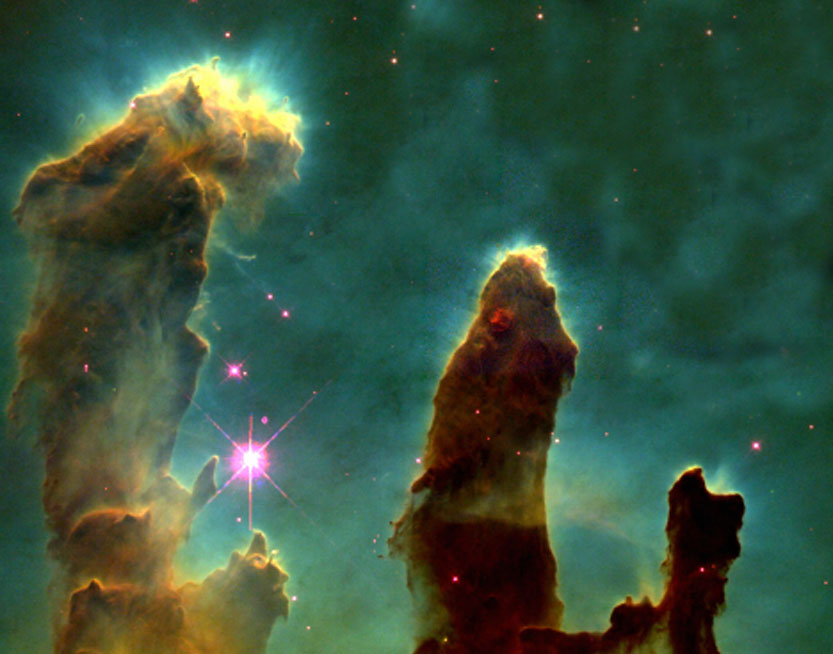The year 2009 is the international year of astronomy; it marks 400 years since Galileo used the telescope to first look up at space. As part of the celebration NASA and other astronomical societies having been doing things to celebrate. NASA is doing its part this month by allowing the public to be the astronomers. They have put the public in control of the Hubble Space Telescope. NASA has picked six astronomical objects and is allowing the public to vote on which object Hubble will view and collect data on next. I decided to go over each of the six objects and describe what they are and why they might be of interest.
The first object is a star-forming region called NGC 6334 also known as the Cat’s Paw Nebula or the Bear Claw Nebula. It is located in the Scorpius constellation that is located in the southern hemisphere near the center of the galaxy. It is located about 5,500 light years away. It glows with a deep red color that originates from a large amount of ionized hydrogen in the area. The nebula is usually obscured by large amounts of gas and dust sometimes making it difficult to observe from ground based telescopes. The region is a very active star-forming region, which is the reason it is considered for observation. Observing these star forming regions tells us a lot about the birth and evolution of stars, and the interaction of a large number of young stars in close proximity to each other.
The second contestant is the planetary nebula NGC 6072, which is also located in the constellation Scorpius. There is not much information available on this object and it has not been viewed very often. It is a remnant of a dead low mass star; a white dwarf with an envelope of gas and molecules surrounding it that were puffed off layers of the star as it was dying. Observing planetary nebulas is always useful, it gives us information about stars after they die and how the elements given off interacts with surrounding gas and dust. They also usually make for very pretty pictures.
The third object is planetary nebula NGC 40, otherwise known as the Bow-Tie Nebula. It is located about 3,500 light years form Earth in the constellation Cepheus. It is also composed of hot gas surrounding a dying/dead star. The white dwarf left behind radiates at about 50,000 degrees C and the gas envelope at about 30,000 degrees C. This nebula has been imaged more than the other nebula, perhaps making it a less attractive candidate.
The fourth object in the contest is the spiral galaxy NGC 5172. It is located at a distance of about 57 mega parsecs or about 150 million light years. It is a spiral type Sbc. IT has been a host to several well-documented supernovae. From what we can tell it is very similar in size and shape to our own Milky Way galaxy, which is the reason it may be a good candidate for study. Since we can not get an outside looking in view of our own galaxy studying ones similar to our own tell us information we could not otherwise get.
The next possible object is the edge on galaxy known as NGC 4289. It is located in the Virgo Constellation about 50 million light years away. It is also a spiral galaxy but instead of being viewed face on it is seen completely edge on. There are advantages to looking at the same types of things from different views; especially with astronomy. When looking at things so far away with things obstructing your view, light traveling so far, being bent around objects being able to see galaxies edge on can help with verifying measurements of brightness, velocity and other variables.
The last option for an object to choose is Arp 274, or NGC 5679, and is actually two (possibly three) galaxies interacting with each other. It is also located in the Virgo constellation. Interacting galaxies are treasure-troves of data. By studying them we can information on formation and evolution or galaxies. We get information on how these interactions affect star formation, surrounding galaxies, central black holes, and more. I think this is a great candidate for further study.
So those are the six objects open for voting. I encourage any readers to go check out NASA’s site and vote. I personally think this was a great idea on NASA’s part. Hubble has always been very popular and a great tool for creating public interest in astronomy, which can at times be hard to do. I think it’s smart to give the general people the option to pick what they think is interesting and what they want to know more about. I encourage anything that the industry wants to do to try and rose public support, especially in times when funding is hard to come by NASA needs to keep the public in its corners. I’m excited to see who the winner will be.
